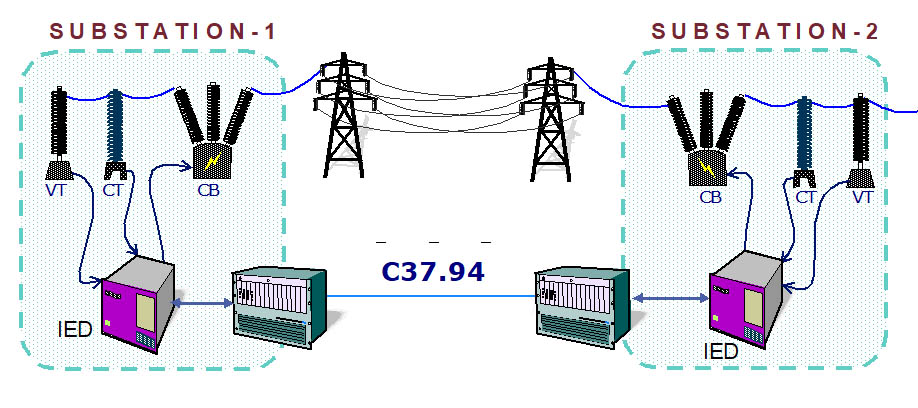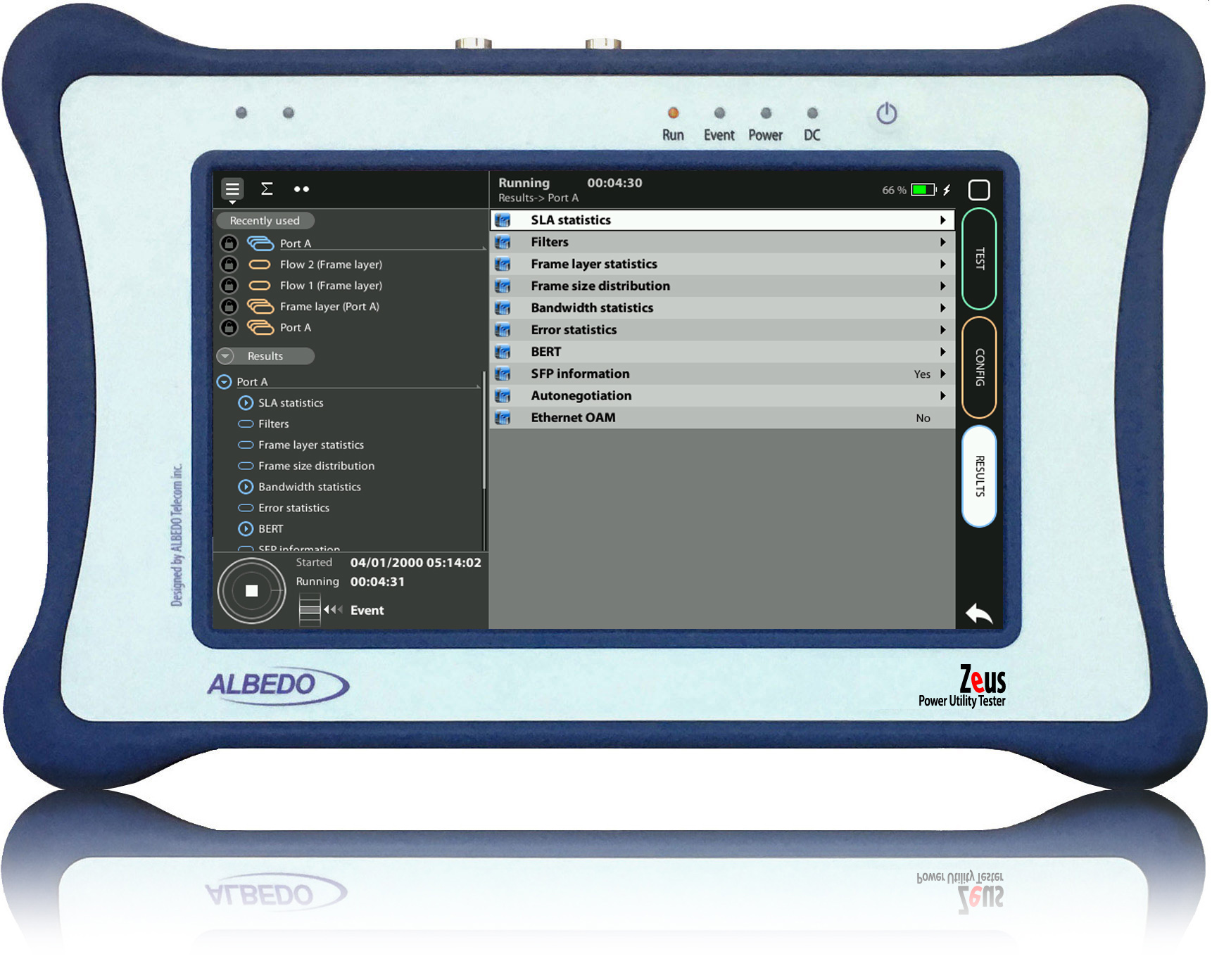One-Way Delay over C37.94
One-Way Delay test is important for verifying IEEE C37.94-compliant teleprotection systems because it directly assesses critical aspects such as timing, fault response, coordination, compliance with standards, and overall network reliability.
BARCELONA NOV.17.2023
About C37.94 protection
IEEE C37.94 is a standard for teleprotection communication and control in power utilities, focusing on the communication aspects that ensure reliable operation of protection relays. Teleprotection involves the use of communication channels to transmit signals between relays to coordinate the strategy for isolating faults in the power system, including substations and distribution lines.

Fig 1. Protection schemes are based on the measurement of electric values and a communication link.
C37.94 defines the formats and protocols to be used in the telecommunications network, including data frames, transmission rates and other requirements that enable the use of protection schemes in power systems. This has always been considered a critical system to facilitate interoperability between substation connections of generation plants and the reliability power service.
Ensuring the standard implementation
Ensuring that equipment supports the standard is key to the reliability and interoperability of the system, so conformance testing verifies that equipment from different manufacturers can work together seamlessly, promoting a more robust and reliable power infrastructure. All engineers involved in the deployment or maintenance of C37.94 teleprotection should review and follow the manufacturer’s test procedures to ensure conformance testing.

Fig 2. C37.94 line protection.
Field engineers can use ALBEDO testers to check new C37.94 installations or to troubleshoot tele-protection relays and multiplexers using features such as Bit Error Rate Test (BERT), G.821, Event Analysis/Generation, Optical Power Meter One-Way/Round-Trip Delay, etc. to help engineers verify the protection system that prevents outages in a substation.
One-Way Delay test
The One-Way Delay (OWD) test with GPS is important for verifying teleprotection systems:
- Timing Requirements: IEEE C37.94 includes specific timing requirements for the transmission of signals.
- Coordination of Relays: Protective relays may need to coordinate their actions to isolate faults effectively then delays adheres to the specified limits, supporting proper coordination and sequence of actions.
- Accuracy: Teleprotection rely on precise timing to coordinate protective actions across different devices then OWD test verifies the accuracy by comparing the time stamps at the source and destination using a common time reference provided typically, not always, by GPS.
- Synchronization: Protective relays need to be synchronized minimizing the risk of miscoordination and improving the overall reliability of the protection scheme.
- Compliance: C37.94 specify requirements for timing and synchronization. Conducting the OWD test with GPS allows verification of compliance with these standards, ensuring interoperability and adherence to industry guidelines.
- Response Time: The OWD provides a valuable information about the delay introduced by the system then it is crucial to know the delay for evaluating the system’s ability to detect faults promptly and initiate protective actions.
- Redundancy: In teleprotection systems, having accurate and synchronized timing is essential for the reliable operation of redundancy mechanisms. The OWD test with GPS helps ensure that backup or redundant teleprotection paths are properly synchronized, contributing to system reliability.
- Reliability: Consistent and predictable delays are essential for the reliable and secure operation of the teleprotection system.
- Performance Monitoring: Identifying and addressing delays or variations in performance facilitates the maintenance of the the quality of service and enhance the system’s reliability.
- System Integrity: The accurate and timely transmission of signals is fundamental to the proper functioning the protection system.
One-Way Delay test is crucial for verifying and ensuring the accuracy, synchronization, and compliance of C37.94 systems with industry standards.

Fig 4. One-way delay requires the use of two synchronized testers.
xGenius and Zeus
xGenius and Zeus testers provide in-depth insight into the design, installation, maintenance, troubleshooting and engineering of Smart Grid communications infrastructures. The unit can test Ethernet/IP, PTP, GbE, IRIG-B, T1/E1, G703, C37.94 and GOOSE, SV and MMS protocols. One-way delay testing, supported by GPS, is available on all interfaces. Zeus has a set of programmable filters to capture live traffic at wire speed. You can now analyse GOOSE, SV, MMS and other protocols to decode and store them in PCAP format or calculate propagation delay from local or remote substations.

Fig 4. Zeus the favorite tester of field engineers from Canada to Australia, from Germany to South Africa.
Testing C37.94 with ALBEDO
Using a dual port module over SMF or MMF with a suitable SFP and then a configurable bit rate between 64kbps and 768kbps in 64kbps increments.
Connectors
- Dual port operation over SMF or MMF with suitable SFP
Line
- Transmission clock: Recovered or internally synthesized
- Laser on and off control
Frame
- Unframed or framed operation.
- Frame structure follows IEEE C37.94 section 4.1
- Configurable bit-rate between 64 kb/s and 768 kb/s in steps of 64 kb/s

Fig 5. ALBEDO tester equipped with C37.94 double port module.
Line Analysis
- Frequency (Hz), frequency deviation (ppm)
- Transmitted optical power (dBm), received optical power (dBm)
- Received data rate (kb/s)
- SFP information: transceiver, vendor, model and wavelength
Frame and Pattern Analysis
- ITU-T G.821 performance: ES, SES, UAS, DM. ITU-T G.821 results include pass / fail indications
- Event detection and insertion: LOS, AIS, FAS, RDI (yellow), LSS, ALL0, ALL1, Slip, TSE, bit error, delay


